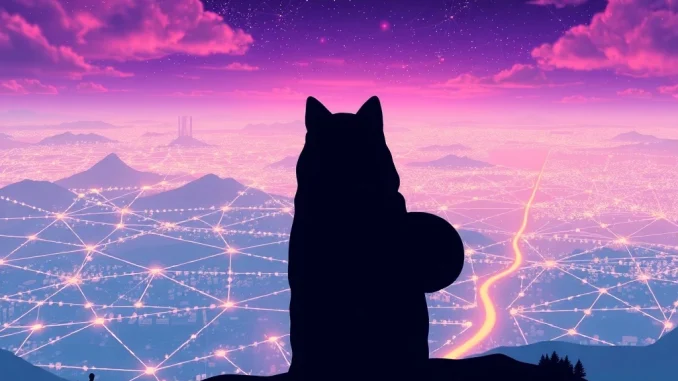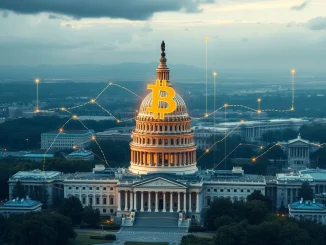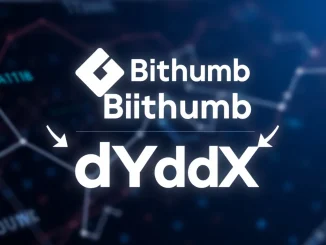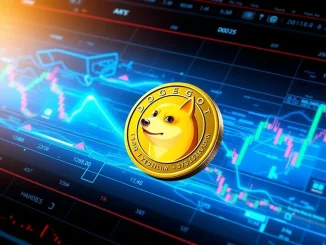
The cryptocurrency world is no stranger to mysteries, but few compare to the enigmatic journey of Shiba Inu (SHIB) and its elusive founder, Ryoshi. From its humble beginnings as a decentralized experiment, SHIB has defied expectations, reaching an astounding $40 billion market peak. But what truly sets this project apart isn’t just its meteoric rise; it’s the unprecedented act of its creator stepping away entirely, pushing the boundaries of true decentralization.
The Enigma of Ryoshi: A Vision for True Decentralization
The name Ryoshi remains one of the most intriguing in the crypto sphere. In August 2020, this enigmatic figure launched Shiba Inu, not as a typical startup, but as a bold, decentralized experiment. The core idea was simple yet revolutionary: a meme-inspired token with no centralized leadership, designed to be community-driven from its inception. Ryoshi’s vision extended far beyond a mere novelty token; they laid the groundwork for a comprehensive ecosystem, including:
- LEASH and BONE tokens: Integral parts of the ecosystem’s utility and governance.
- ShibaSwap: A decentralized exchange allowing users to trade, stake, and earn.
- Shibarium: A forthcoming Layer-2 blockchain aimed at enhancing scalability and reducing transaction costs.
- A Metaverse Project: Expanding SHIB’s utility into virtual worlds.
A pivotal moment in SHIB’s early history involved Ethereum co-founder Vitalik Buterin. Half of the initial quadrillion-token supply was sent to Buterin, who later burned a staggering 410 trillion tokens and donated a significant portion to India’s COVID-19 relief efforts. This act not only removed a vast amount of tokens from circulation, potentially increasing scarcity, but also significantly cemented Shiba Inu‘s legitimacy in the broader crypto landscape.
Why Did the Shiba Inu Creator Vanish?
Ryoshi’s approach was marked by a deliberate absence of personal identity or financial gain. They never disclosed their real name, nationality, or professional background, emphasizing anonymity as a core principle. This commitment to anonymity culminated in 2022 when Ryoshi fully exited the project. This wasn’t a quiet departure; it was a deliberate erasure of all digital traces—including social media accounts, blog posts, and wallets.
Their final, poignant statement resonated deeply: “I am not important, and one day I will be gone without notice.” This move underscored their unwavering commitment to decentralization, ensuring Shiba Inu’s future would be shaped entirely by its community, affectionately known as the “ShibArmy.” By removing any potential for centralization or personal profit, this crypto founder aligned their actions with the philosophy that the token should belong solely to its holders, not its creator.
SHIB’s Astonishing Ascent and Ryoshi’s Legacy
The impact of Ryoshi’s actions continues to resonate. Despite SHIB reaching a peak market capitalization of $40 billion in 2021, Ryoshi’s net worth is now widely regarded as negligible, if not zero. They neither retained tokens nor engaged in any exit strategy, a stark contrast to many crypto founders who prioritize personal wealth. This decision has elevated Ryoshi’s status among idealists who view them as a symbol of humility and integrity in an industry often driven by speculation and ego.
By mid-2025, Ryoshi’s legacy is defined not by financial metrics but by the principles of decentralization, accessibility, and community empowerment embedded in Shiba Inu’s ecosystem. Their actions challenged the traditional notion of a founder’s role, proving that a project can achieve immense success even when its creator steps entirely into the shadows.
Decentralization in Action: The ShibArmy’s Power
SHIB’s success has also profoundly influenced the broader crypto landscape. Its grassroots energy and functional use cases—spanning DeFi, NFTs, and metaverse initiatives—have set it apart from many other meme coins. The project’s ability to thrive without a central figure has demonstrated the viability of community-led innovation, inspiring a new wave of decentralized experiments.
The Shiba Inu community, the ShibArmy, has become a formidable force, driving development, marketing, and adoption. Ryoshi’s writings, though sparse, are frequently cited as foundational to the ShibArmy’s ethos, emphasizing trustlessness and collaboration over hierarchy. This collective effort highlights the true power of decentralization, where decisions and progress stem from a distributed network of passionate individuals rather than a single entity.
Navigating the Challenges of a Founderless Crypto Project
Critically, Ryoshi’s exit highlights both the challenges and opportunities inherent in decentralized projects. While SHIB’s ecosystem has expanded to include Shibarium and ShibaSwap, its long-term sustainability depends on sustained community engagement and technological development. The absence of a central authority can both empower the community and complicate governance, requiring robust mechanisms for decision-making and conflict resolution.
However, Ryoshi’s model has proven that decentralization, when executed with clarity and intent, can foster projects with global reach and cultural significance. The transparency and trustlessness that come with a truly decentralized structure can be a significant advantage, as the project’s fate rests entirely with its community, aligning incentives and fostering genuine collaboration. The journey of Shiba Inu stands as a testament to this unique approach to building in the crypto space.
The Shiba Inu story remains a testament to the power of anonymity and idealism in crypto. Ryoshi’s vanishing act was not a retreat but a strategic step to ensure the project’s autonomy. Their actions have redefined the role of founders in the space, challenging the notion that success in crypto requires visibility or personal wealth. As the ShibArmy continues to build on this profound vision, Ryoshi’s influence lingers—not as a figurehead, but as a reminder that true innovation sometimes requires letting go.
Frequently Asked Questions (FAQs)
Who is Ryoshi, the founder of Shiba Inu?
Ryoshi is the pseudonymous and now-vanished founder of Shiba Inu (SHIB). They maintained complete anonymity, never revealing their real name or background, and ultimately deleted all their digital traces, emphasizing their belief in full decentralization for the project.
What does it mean for Shiba Inu to be ‘fully decentralized’?
Full decentralization for Shiba Inu means that the project operates without a central authority or single leader. Decisions, development, and the future direction of the ecosystem are driven by the community, known as the ‘ShibArmy,’ through various governance mechanisms.
How did Vitalik Buterin influence Shiba Inu?
Vitalik Buterin, co-founder of Ethereum, received half of Shiba Inu’s initial token supply. He subsequently burned 410 trillion SHIB tokens and donated a significant portion to India’s COVID-19 relief efforts, which greatly enhanced SHIB’s visibility and legitimacy in the crypto world.
What is Shibarium and its role in the SHIB ecosystem?
Shibarium is a Layer-2 blockchain developed for the Shiba Inu ecosystem. Its primary role is to enhance the scalability of the SHIB network, reduce transaction fees, and provide a more robust infrastructure for the growing ecosystem, including ShibaSwap and future metaverse initiatives.
Why did Ryoshi exit the Shiba Inu project?
Ryoshi exited the Shiba Inu project to ensure its complete decentralization. By removing themselves entirely and deleting all personal traces, they aimed to prevent any single entity from controlling the project, aligning with their philosophy that the token should belong solely to its community.



